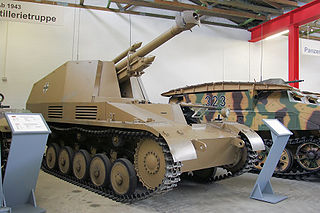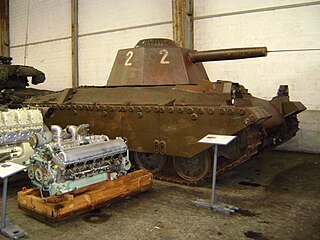
Self-propelled artillery is artillery equipped with its own propulsion system to move toward its firing position. Within the terminology are the self-propelled gun, self-propelled howitzer, self-propelled mortar, and self-propelled rocket artillery. They are high-mobility vehicles, usually based on continuous tracks carrying either a large field gun, howitzer, mortar, or some form of rocket/missile launcher. They are usually used for long-range indirect bombardment support on the battlefield.

The SU-122 was a Soviet self-propelled howitzer or assault gun used during World War II. The number "122" in the designation represents the caliber of the main armament, a 122 mm M-30S howitzer. The chassis was that of the T-34.

The Jagdpanzer 38, originally the Leichter Panzerjäger 38(t), known mostly post-war as Hetzer, was a German light tank destroyer of the Second World War based on a modified Czechoslovakian Panzer 38(t) chassis.

The Sturmgeschütz III was an assault gun produced by Germany during World War II. It was the most-produced fully tracked armoured fighting vehicle, and second-most produced German armored combat vehicle of any type after the Sd.Kfz. 251 half-track. It was built on a slightly modified Panzer III chassis, replacing the turret with an armored, fixed superstructure mounting a more powerful gun. Initially intended as a mobile assault gun for direct-fire support for infantry, the StuG III was continually modified, and much like the later Jagdpanzer vehicles, was employed as a tank destroyer.

Hummel was a German self-propelled gun used by the Wehrmacht during World War II. Based on the Geschützwagen III/IV chassis and armed with the 15 cm sFH 18/1 L/30 howitzer, it saw action from early 1943 until the end of the war. Its ordnance inventory designation was Sd.Kfz. 165.

The Sd.Kfz. 124 Wespe, also known as Leichte Feldhaubitze 18/2 auf Fahrgestell Panzerkampfwagen II (Sf.), is a German self-propelled gun developed and used during the Second World War. It was based on a modified Panzer II chassis.

Verdeja was the name of a series of light tanks developed in Spain between 1938 and 1954 in an attempt to replace German Panzer I and Soviet T-26 tanks in Spanish service.

The Panzer 61 was a Swiss Cold War era medium tank later reclassified as a second-generation main battle tank. The tank had a weight of 36.5 tons and was powered by a 630 hp diesel engine, which gave it a top road speed of 50 km/h (31 mph). The primary armament of the Panzer 61 was a 105 mm main gun.

The Panzer 68 was a Swiss main battle tank developed by the Eidgenoessische Konstruktionswerkstaette in Thun in the late 1960s, and was the main tank of the Swiss Army until the late 1990s.

The Mowag 4x4 armored dummy is a target practice vehicle used by the armed forces of Switzerland.

The Entpannungspanzer 65 is a Swiss armored recovery vehicle developed by Eidgenoessische Konstruktionswerkstaette Thun in the late 1960s. The vehicle served as a traveling workshop for the Swiss military.

The Zielfahrzeug 68 was a decommissioned Panzer 68, which was converted to the target vehicle role. A total of ten of these vehicles were in use.

The Mittlerer Panzer 1958 or Panzer 58 was a medium tank of Swiss design. Twelve tanks were produced and later converted to Panzer 61s.

Eidgenössische Konstruktionswerkstätte English: "Federal Constructions Works", short K+W, was a Swiss state-owned enterprise, with the aim of making the Swiss military independent of foreign sources for its equipment needs. It was established in 1867 in Thun and produced artillery, vehicles and other typical military equipment. In 1914 Switzerland put in an effort to make itself independent of foreign suppliers of military aircraft and started the production of the DH-1 in Thun. Long-standing connections to the ETH Zurich ensured the necessary know-how. 1940 the aviation department moved from Thun to Emmen (LU) and in 1943 it became a separate unit of the Swiss Armed Forces independent under the name of Eidgenössisches Flugzeugwerk (F+W). The Eidgenoessische Konstruktionswerkstaette focused now on the production of armoured fighting vehicles for the Swiss Army, both of its own designs and licensed production of M113 armored personnel carriers and Leopard 2 tanks and other land systems for the Swiss Army. Since 1995 it changed its name several times, started exporting and is now part of RUAG Defence.

The Swiss Military Museum is located at Full-Reuenthal in the Canton of Aargau.

The M548 is a tracked cargo carrier. It is based on the M113 armored personnel carrier, and was built by FMC Corp. at its San Jose, California, and Charleston, West Virginia facilities.
The Panzer 2000 was a Swiss tank planned to replace the Panzer 68, produced by Eidgenoessische Konstruktionswerkstaette. It was intended for use by the Swiss Armed Forces.
The 10.5 cm leFH 16 Geschützwagen Mk VI 736 (e) was a German self-propelled artillery piece. It was created by mounting the German 10.5 cm leFH 16 field howitzer onto the chassis of the British Light Tank Mk VI. The vehicle was created by engineer Alfred Becker, who was battery chief of the 12th Battery in the 15th Artillery Regiment, 227th Infantry Division. Becker found abandoned vehicles while his unit was performing coastal protection duties in France. He made use of his artillery crews to build this vehicle and a number of others to motorize his battery. Becker's unit operated the first purpose-built self-propelled artillery of the war. A previous rough-and-ready conversion, the 15 cm sIG 33 (Sf) auf Panzerkampfwagen I Ausf B, had merely put a sIG 33 inside a superstructure, complete with wheeled carriage.

The M109, a widely-used American howitzer, has been operated by the Swiss Armed Forces since 1971. Under Swiss operation, the M109 has received numerous modernisations, though it is gradually being phased out of service, as its service life is approaching its end.

















